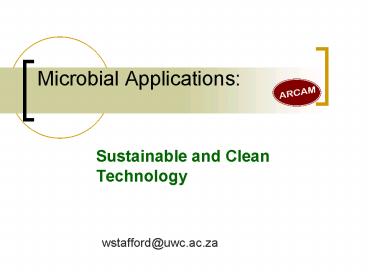Microbial Applications: - PowerPoint PPT Presentation
1 / 17
Title:
Microbial Applications:
Description:
... be divided into a number of basic stages- extraction and supply of raw materials; ... by expanding natures repertoire (mutagenesis, molecular evolution etc. ... – PowerPoint PPT presentation
Number of Views:247
Avg rating:3.0/5.0
Title: Microbial Applications:
1
Microbial Applications
- Sustainable and Clean Technology
wstafford_at_uwc.ac.za
2
Industrial clean technology
- Industrial process can be divided into a number
of basic stages- extraction and supply of raw
materials processing of the raw materials/
production of product use of the product and
disposal of the product. - The objectives of a sustainable industrial
process are as follows - low consumption of energy
- low consumption of non-renewable raw materials
- eliminate waste at all stages (reduce, re-use,
recycle)
3
Microbial applications
- Useful product- bulk and fine chemicals (e.g
ethanol, acetone, biosurfactants and bioplastics)
- Supply of clean raw materials
- Recovery of metals (biomining and bioleaching)
- Recovery of wastes (sewage treatment,
bioremediation, pytoremediation and
bioaugmentation) - Agricultural Biotechnology (GMO food crops)
- Biomarkers, Bioindicators and Biosensors
4
Desulphurisation of oil
- The burning of fossil fuels, petrol, diesel, and
coal, releases sulphur oxides into the atmosphere
which are the principal cause of acid rain - Crude oil contains between 0.05 and 5.0 sulphur
compounds. Majority (70) of the sulphur in
crude oil is found as dibenzothiophene (DBT) or
substituted DBT. - Chemical desulphurisation is carried out by
decomposition with hydrogen at high temperature
and pressure (1035-20 700 kPa and 230-455C) - Biological desulphurization is possible as a
number of microorganisms have been isoloated
which can degrade DBT and include Rhodococcus
spp., Agrobacterium, Gordona, Klebsiella,
Nocardiaglobelula, Paenibacillus, Pseudonmonas
5
Desulphurisation of coal
- Coal is a heterogeneous solid that contains a
variety of organic and inorganic sulphur
compounds that will vary with source.
The main organic sulphur compounds in coal are
the DBTs. Inorganic sulphur is mostly as iron
pyrite
6
Microorganisms a better option for sulphur
removal?
- Changes in combustion at the power station can
reduce the emission of sulphur dioxide by
fluidized-bed combustion. Pulverized coal is
fluidized by an airstream, which ensures that the
coal is completely burnt. Limestone is added to
trap the sulphur as a molten slag. This process
requires advanced combustion designs and is not
applicable to all power stations. - An alternative is to use microorganisms that will
metabolize the components of coal.
7
- The inorganic sulphur in coal can be oxidized by
chemolithotrophs like Thiobacillus ferrooxidans,
Thiobacillus thiooxidans, and Sulfolobus
acido-caldarius, which are responsible for acidic
mine drainage. Linked to the oxidation of reduced
iron, T. ferrooxidans generates energy by the
direct oxidation of iron (II) sulphide to iron
(I) sulphate - 2FeS2 7O2 2H2O 2FeSO4 2H2SO4
- Microbial action can also directly convert
elemental sulphur to sulphuric acid. - 2S 3O2 2H2O 2H2SO4
- The main organic sulphur compounds in coal are
the DBTs. The organic sulphur compounds are an
integral part of the coal matrix and therefore
are much more difficult to remove than the
pyrites (enzymic cleavage of CS). Various
micro-organisms can degrade DBTs Rhodococcus sp.
(Gray et al., 1996), Pseudomonas spp. TG232
(Kilbane, 1989), Brevibacterium sp. (McEldowney
et al., 1993), and Aspergillns niger
8
(No Transcript)
9
Untreated soil Rhodococcus ECRD-1 treated
soil
10
Results Bio-desulphurisation of coal
11
Enzymes
- Micro-organisms and enzymes can replace inorganic
catalysts that are used in the conventional,
chemical methods. This has several advantages - Use less energy (lower Ea)
- Reactions can be very specific (stereo
specificity) - Reactions are fast and effective to give reduced
process times - Produce less toxic waste
- Generally use renewable resources
- We can also use molecular biology methods
(mutagenesis, gene shuffling and molecular
evolution) to possibly improve the organism or
enzyme to the desired task. - Also, enzymes are now available from
extremophiles
12
Enzymes as stereo-specific catalysts
- Single enzymes are excellent catalysts that can
perform regio- and stereo-specific reactions.
Micro-organisms can also be regarded as
multiple-enzyme containers that can carry out one
or multiple reactions. One of the best examples
of the very specific nature of enzymes is the
production of steroids,
13
Industrial applications of enzymes
14
Industrial applications of enzymes
- Laundry detergents-addition of lipase, protease,
and amylase to detergents allowed the use of
lower temperatures, and the better removal of
specific stains. There has been continual
development of enzyme detergents with increased
activity at low and high temperatures and at
alkaline pH values. - Textile industry has used alkaline proteases for
degumming silk, removing a protein from the
outside of the silk fibres (Gupta et al., 2002).
Pectinases used to remove cell-wall components
from cotton fibres and glucose oxidase used to
bleach the fibres. Cellulases have been used to
treat denim garments as an alternative to
stonewashing in a process known as biostoning
(Belghith et al., 2001). - Leather Replacement of the chemical processes by
enzymes should have considerable advantages.
Proteases have been used to de-hair hides and
lipase to remove fat. - Paper Cellulases have been used to assist
pulping, and to de-ink paper. Laccase enzymes
that attack lignin have been used to bleach pulp
as an alternative to chlorine bleach (Kirk et
al., 2002).
15
Extremophiles
- The microorganisms found in extreme conditions of
temperature, salt, and pressure belong to the
domains of Bacteria and Archaea, but the
majority-are the Archaea. - Clearly these types of micro-organism will
contain enzymes that can function under extreme
conditions. e.g Thermus aquaticus (Taq polymerase
enzyme for PCR)
16
Enzymes from Extremophiles
- (Eichler, 2001 Haki and Rakshit, 2003 Huber and
Stetter, 1998).
17
Developments in Industrial Microbial Applications
- Identify the huge diversity of microorganisms and
the huge potential of uncharacterized genes and
gene products (gene identity and function) - Develop sustainable, renewable technologies using
microorganisms and their products - Solve some of the problems of enzyme stability by
expanding natures repertoire (mutagenesis,
molecular evolution etc.)































